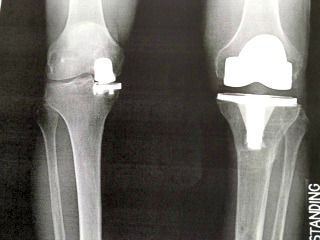by Dr. Jeff Todd
 Yes, these are actually my knees. At 58 years old I’ve had more parts replaced, and joints “cleaned up” than I care to remember. So far, one partial knee replacement on the right, followed by a full knee replacement on the left, I’ve also got advanced arthritis in both shoulders. I’ve got a sister who is four years younger than me, and she had a hip replaced over 10 years ago in her early 40’s. We’re like Labrador Retrievers—prone to arthritis.
Yes, these are actually my knees. At 58 years old I’ve had more parts replaced, and joints “cleaned up” than I care to remember. So far, one partial knee replacement on the right, followed by a full knee replacement on the left, I’ve also got advanced arthritis in both shoulders. I’ve got a sister who is four years younger than me, and she had a hip replaced over 10 years ago in her early 40’s. We’re like Labrador Retrievers—prone to arthritis.
As an arthritis sufferer, I have special empathy for the patients who hobble into my exam room. I know all too well what the chronic pain of arthritis feels like, and so this month I’d like to help you see signs that your dog or cat is developing arthritis, and be sure you know what we can do about it.
When you bring your pet in for annual, or bi-annual physical examinations, we routinely examine the joints for mobility, and signs of arthritis. Regular physical exams help us detect joint problems early and start therapy.
Here’s what you’ll typically see first at home—
Stiffness and slowness getting up.
Reluctance to jump up into the car, or onto the sofa, or reluctance to jump off a sofa- especially onto an slick floor.
Limping while walking, or after exercise.
Reluctance to run, fetch, or play.
What’s a responsible pet parent to do?
If you notice any of these signs, bring your pet in for an exam. Arthritis affects both dogs and cats. I’ve examined enough joints in 32 years that I can get a pretty good idea if arthritis is affecting joints just with a “hands on” exam. Radiographs can also help us determine exactly how severe the disease is, especially when hips are involved.
Once we have a diagnosis of arthritis, our next goal is to slow down the progression of the disease, and control the pain.
Top Tips for Treating Arthritis:
Feed the highest quality diet possible. Many clients report that their arthritic pets do much better on a grain-free diet- ideally a raw or home cooked diet.
Keep your arthritic dog or cat fit and trim. Your pet should be at, or slightly below, their ideal weight. Arthritis is far more painful for overweight pets. There’s no supplement or medication we can give that has as much benefit as being at a healthy body weight. If you need help getting your pet to shed a few pounds, we’re here to help you with any and all diet related questions.
Supplement your pet’s high quality diet with high quality fish oils – a natural anti-inflammatory supplement. We have Nordic Naturals fish oil at Noah’s Ark. This is an extremely high quality line of oils that we take ourselves. Click here to read more about the health benefits of fish oil.
If you’re using fish oil, supplement your pet’s diet with additional Vitamin E– 100 IU for small dogs and cats, 200 IU for medium sized dogs, and 400 IU large dogs.
There are many natural supplements we use to try to slow the progression of arthritis and alleviate the pain. These decisions are all dependent on your pet’s individual case and lifestyle.
Once we get some pain control on board, try to keep your pet active. Swimming is great exercise if you have access to a pool or lake -not advised with your cats– although, in Raleigh we had an in ground pool just for the dogs. When one of our cats accidentally fell in, I discovered they’re quite efficient swimmers!
Some of our arthritis patients respond very well to acupuncture. We have 5 session packages available to make this option affordable.
Be sure to provide your arthritic patient with a thick cushioned bed – not only for comfort, but to insulate from the cold floor (particularly this winter).
In severe cases, we have a number of great prescription arthritis drugs. These drugs can really improve quality of life for patients with advanced arthritis disease.
The point I want you to remember this month is that we can keep your pets comfortable, with a high quality of life, well into their senior years – even if they do develop arthritis. Take it from me, arthritis pain does deserve to be controlled. Let us help!
